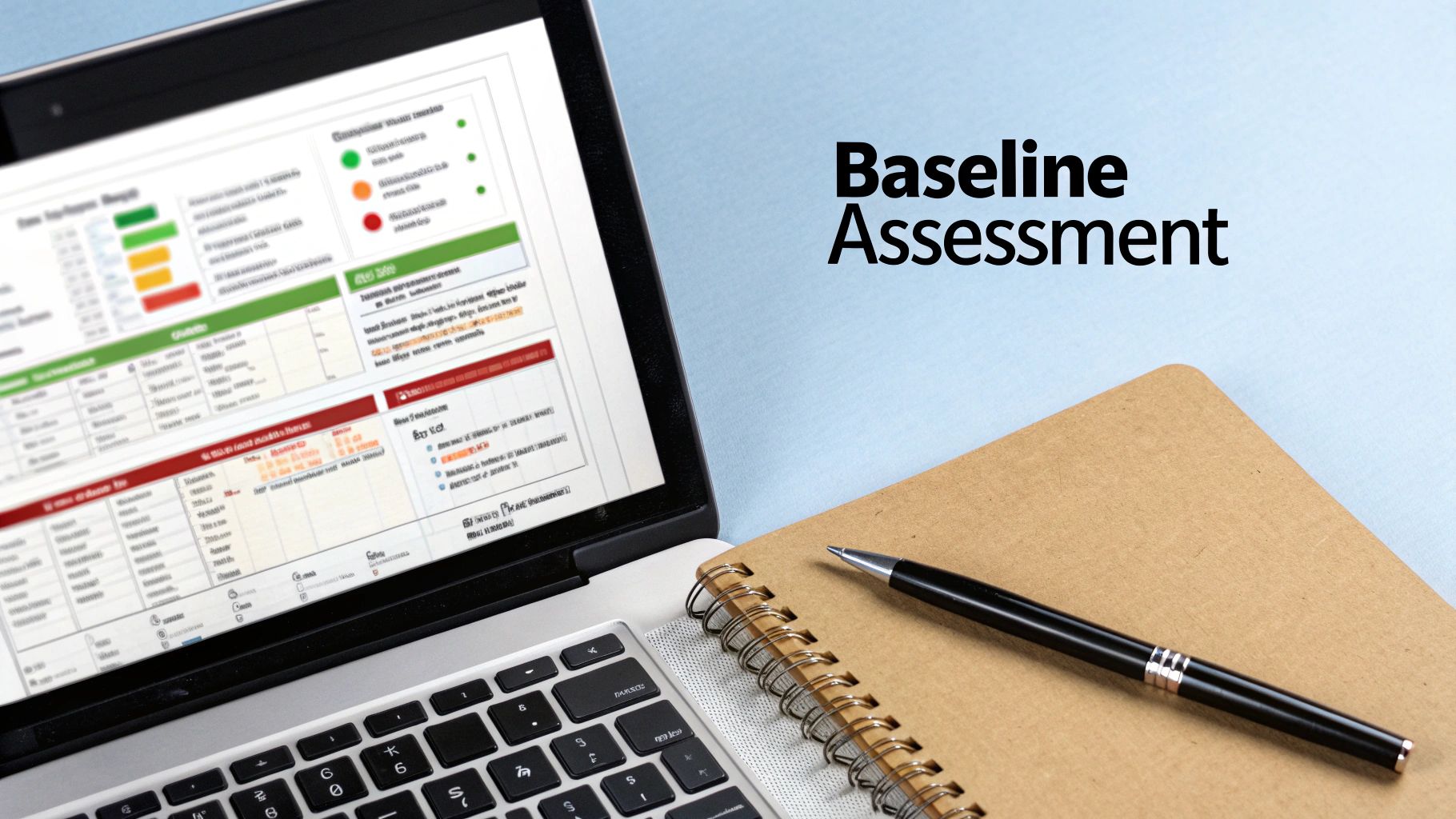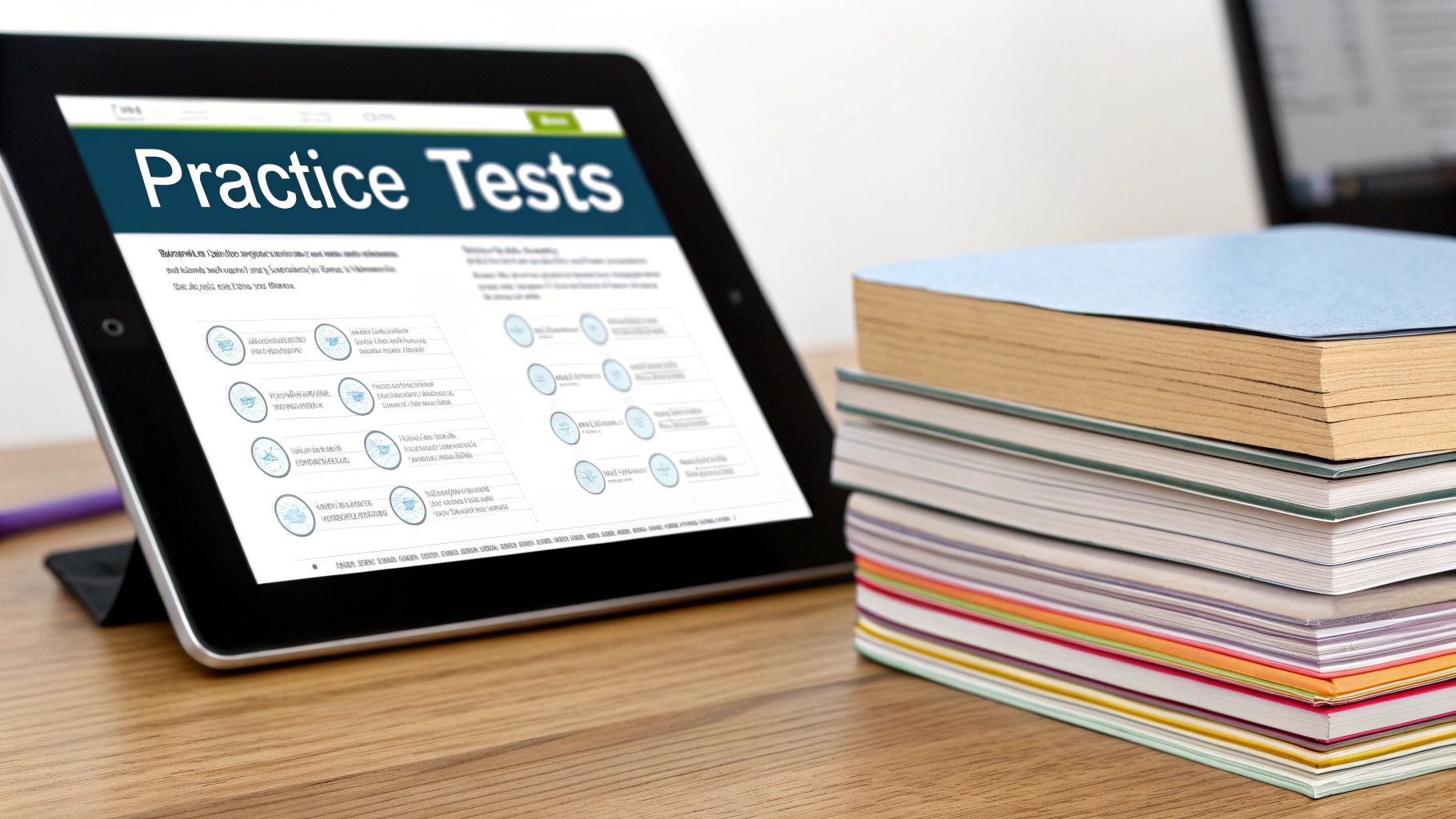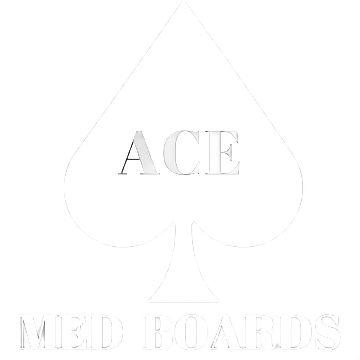Building a killer USMLE Step 2 study schedule isn’t about just plugging dates into a calendar. The real work happens before you even think about daily plans. It’s about creating a truly personalized strategy that reflects your clinical foundation, your background, and where you want to land with your score—something that’s become even more critical now that Step 1 is Pass/Fail.
Laying the Groundwork for Step 2 Success

Before you start mapping out your weeks, you need to get real with yourself. An honest self-assessment is the absolute bedrock of a realistic, effective study plan. This isn’t the time to copy a template you found online; your unique journey up to this point completely shapes what you need to do next.
Think about it: an International Medical Graduate (IMG) might need to carve out significantly more time for certain topics than a US grad fresh off their core rotations. The entire goal here is to craft a plan that fits you, not the other way around.
Pinpoint Your Strengths and Weaknesses
First, take a hard look at your third-year clerkships. Which rotations felt like an uphill battle? Was it the rapid-fire decision-making in surgery that tripped you up, or the subtle diagnostic puzzles in internal medicine? Your Shelf exam scores are gold here—they provide the objective data you need to see exactly where you stand.
A brutally honest evaluation of your knowledge gaps is, without a doubt, the most crucial part of this entire process. It’s what tells you where to point your energy.
Your USMLE Step 2 study schedule should not be a one-size-fits-all document. It is a strategic tool that must be calibrated to your individual strengths, weaknesses, and ultimate career goals.
This self-scouting directly dictates your timeline. If you have a rock-solid clinical base, you might crush it with an intense 4-week dedicated period. But if you have several weak spots to shore up or you’re balancing studying with other life commitments, a more forgiving 8- or 12-week schedule makes a lot more sense. To really make this stick, it helps to lean into how our brains actually work. Building your plan around science-backed tips for effective learning can give you a serious cognitive edge for this marathon.
Understand the Stakes and Your Background
The data really underscores why a tailored plan is so important. The Step 2 CK exam is a massive hurdle. First-time takers from US/Canadian MD programs have an impressive 98% pass rate, but that number plummets to 74% for those repeating the exam. For IMGs, the stakes are even higher: an 89% first-time pass rate drops to just 61% for repeaters. These numbers scream one thing: a well-organized plan from the get-go is non-negotiable.
Ultimately, this whole prep phase is about defining what success looks like for you.
- Identify weak subjects: List the clerkships where you felt the least confident or scored the lowest.
- Set a target score: Do your homework. What are the average scores for the specialties you’re aiming for?
- Choose a timeline: Based on your self-assessment, decide if you’re gearing up for a short sprint or a longer marathon.
Nailing down these foundational pieces sets the stage for everything else. For a deeper dive into how to tackle your study period, don’t miss our complete guide on how to study for Step 2 CK.
Choosing Your Study Resources Without Getting Overwhelmed

A perfectly crafted USMLE Step 2 study schedule is useless without the right tools. It’s dangerously easy to fall into the “resource overload” trap, piling up subscriptions and Anki decks you’ll never realistically get through. Let’s be clear: the goal isn’t to collect every resource under the sun. It’s to build a lean, powerful, and integrated study arsenal.
The most effective strategy I’ve seen—and used myself—is to layer your resources. This means picking one “Core” resource to be the foundation of your daily grind and then adding a few “Supplementary” tools to hammer home your weak points.
Your Core Resource: The Unquestionable Qbank
For Step 2 CK, your core resource is non-negotiable. It has to be a question bank (Qbank). For the vast majority of students, that means UWorld. Think of it as your textbook, practice exam, and personal tutor all in one. There’s a reason it’s the gold standard.
Your daily schedule should revolve around doing a set number of UWorld questions. But here’s the critical part: you must thoroughly review every single explanation. Yes, even for the questions you got right. This active review process is where the real learning happens and where you start seeing your score climb.
A smart strategy many students use is hitting the AMBOSS Qbank hard during their third-year clerkships. This exposes you to a wide range of questions and saves the UWorld Qbank for your dedicated study period, keeping it fresh for the final push.
High-Yield Supplements for Targeted Review
Once your core Qbank is set, you can strategically layer in a few supplements. These aren’t for learning everything from scratch; they’re for plugging specific knowledge gaps and making high-yield concepts stick.
Here’s what a great supplementary system looks like in practice:
- Spaced Repetition: Use Anki to create flashcards only from your incorrect UWorld questions. The point isn’t to make a card for every factoid but to build a personalized deck of your specific weaknesses. Be strict—just a few high-yield cards per missed question.
- Audio Learning: Divine Intervention Podcasts are an absolute game-changer for passive learning. Listen during your commute, at the gym, or while making dinner. Focus on episodes that cover subjects you struggled with in yesterday’s UWorld block.
- Quick Reference: The AMBOSS Library is an incredible clinical encyclopedia. When a UWorld explanation isn’t quite clicking, a quick search in the AMBOSS Library can give you the clarity you need without sending you down an hour-long internet rabbit hole.
To help you decide, let’s break down how these resources fit together.
Core vs. Supplementary Step 2 CK Resource Comparison
| Resource Type | Example | Primary Use | Best For Learners Who… |
|---|---|---|---|
| Core Qbank | UWorld | Daily practice, content mastery, and exam simulation. The backbone of your entire study plan. | Virtually all students. It’s the standard for a reason. |
| Spaced Repetition | Anki | Long-term memorization of specific, high-yield facts, especially from incorrect questions. | Want to actively combat the forgetting curve and build a personalized review tool. |
| Audio Learning | Divine Intervention | Passive review and learning during non-study time (commuting, exercising, chores). | Are auditory learners or want to maximize their time by learning on the go. |
| Clinical Reference | AMBOSS Library | Quick look-ups for concepts that need more clarification than a Qbank explanation provides. | Need a fast, reliable source to fill in knowledge gaps without getting sidetracked. |
This table shows how each resource has a distinct role. You don’t need five different Qbanks; you need one great one supported by a couple of well-chosen tools.
Remember, the key is integration, not accumulation. Your supplements must directly support what you’re doing in your core Qbank. If you listen to a Divine podcast on cardiology, you should be doing cardiology questions in UWorld that week to reinforce the concepts.
By choosing one core Qbank and 1-3 well-chosen supplements, you create a focused and manageable study ecosystem. This approach prevents the paralysis that comes from having too many options and ensures every hour in your USMLE Step 2 study schedule is spent on activities that will actually move the needle on your score.
Designing Your Personalized Study Timeline
So, you’ve got your resources picked out. Now comes the fun part: actually building your USMLE Step 2 study schedule. A huge mistake I see students make is just jotting down topics day by day without any big-picture strategy. That’s a surefire way to feel like you’re just spinning your wheels.
A much better approach is to break down your entire study period—whether it’s a four-week sprint or a twelve-week marathon—into distinct, purpose-driven phases. This keeps you focused and ensures every week builds on the last. For most students on an 8- to 12-week timeline, a three-phase plan is the gold standard. It moves you from building a foundation to crushing your weaknesses and, finally, to simulating the real deal.
Phase 1: The First Pass
This first chunk of your timeline, usually about 50-60% of your total prep time, is all about building your core knowledge. The main goal here is a complete, system-by-system first pass of UWorld. You might dedicate one full week to cardiology questions, the next to pulmonology, and so on.
This systematic method lets you fully immerse yourself in one subject at a time. You’ll start making connections and seeing patterns that are nearly impossible to spot when you’re just doing random blocks from day one. It’s all about pouring a solid foundation before you start trying to patch any cracks.
Phase 2: Integration and Weakness
Once that first pass is done, it’s time to shift gears. This second phase is dedicated to two things: integration and ruthlessly hunting down your weak spots. From now on, you’ll be doing only random, timed UWorld blocks. This is critical for mimicking the mixed-up nature of the actual exam.
Your main focus should be on meticulously reviewing every incorrect and marked question from your first pass.
I can’t stress this enough: the biggest score jumps happen right here. It’s not about cramming new facts; it’s about mastering the information you’ve already seen but misunderstood. This is where the hard work of review really pays off.
This isn’t just about re-reading explanations. You need to dig deeper and find patterns. Are you constantly fumbling “next best step” questions? Do you always miss the subtle differences between nephrotic syndromes? Identifying these recurring issues is the only way to make targeted, meaningful improvements.
Phase 3: Exam Simulation
The final two weeks are all about building mental and physical stamina. Your attention should shift almost entirely to taking full-length NBME Self-Assessments under strict, exam-day conditions. Your goal should be to complete at least 2-3 of these full-length practice exams.
This final push solidifies your test-taking strategy, sharpens your pacing, and gets you ready for the nine-hour beast that is Step 2. A thorough review of these exams will give you one last, high-yield look at any remaining weak areas just before test day. For more detailed examples of how to map out these crucial final weeks, check out our in-depth Step 2 CK study schedule breakdown.
As you map out your days and weeks, remember that learning some effective prioritization techniques can be a game-changer for deciding where to spend your time. This infographic gives a great visual of how to structure your weeks.

This visual really drives home the need to balance structured learning with the flexibility life requires. It’s also critical to make sure your plan is tough enough for the latest exam standards. As of July 1, 2025, the Step 2 CK passing standard was raised from 214 to 218. This change reflects higher expectations, meaning your study plan needs to be rigorous enough to hit this new, higher target. You can learn more about the passing standard change on the official USMLE site.
Executing Your Daily and Weekly Study Plan
https://www.youtube.com/embed/z3tn3bL2Hd4
A brilliant timeline is just a piece of paper if you can’t execute it day after day. This is where your high-level USMLE Step 2 study schedule gets real, transforming from a concept into a concrete, daily routine. The real magic isn’t in the plan itself but in the consistent, focused work you put in each day. That’s how you turn a good plan into a great score.
A successful study day is all about structure and balance. I can’t stress this enough: this is not about studying for 14 hours straight. It’s about making every single hour count. Your daily template should be built around your core Qbank, with dedicated time for both doing questions and, more importantly, digging deep into the review.
A Sample Daily Structure
For many students I’ve worked with, a schedule built around two UWorld blocks is a fantastic starting point. This framework gives you a solid rhythm for the day without being completely overwhelming, especially when you’re just starting your dedicated study period.
Here’s what that might look like:
- Morning (8 AM – 12 PM): Start with one timed, random 40-question UWorld block. The real work begins after the block: spend the next three hours on an in-depth review of every single question—right, wrong, and the ones you flagged. This deep dive is non-negotiable.
- Afternoon (1 PM – 5 PM): After a lunch break, repeat the process. Hit another timed, random 40-question block, followed by another three hours of intensive review.
- Evening (5 PM onwards): Keep it light. This is a great time to watch a relevant high-yield video or do a small set of Anki cards you made from the day’s incorrects. Crucially, protect this time to rest and recover. Your brain needs it.
I’ve seen it time and time again: the most significant mistake you can make is prioritizing the number of questions over the quality of your review. Spending four hours to deeply understand 40 questions is infinitely more valuable than blasting through 120 questions with only a surface-level glance at the explanations.
Making Your Study Sessions Stick
Getting through these intense blocks requires managing your energy and focus like a pro. The Pomodoro Technique—studying in focused 25-minute sprints with 5-minute breaks—can be a total game-changer for staying sharp. To really get the most out of your study hours and keep your momentum going, it’s essential to learn how to stay focused and boost productivity.
Your review has to be an active process. Don’t just passively read the UWorld explanations and nod along. That’s a recipe for forgetting. Instead, turn what you learn into something tangible.
For every single incorrect question, create 1-3 Anki flashcards that hammer home the specific concept you missed. This simple habit transforms a mistake you made today into a point you’ll gain on exam day.
Finally, wrap up each week with a powerful review session. Carve out an hour on Saturday morning to dive into your UWorld performance data. Pinpoint your weakest systems and use that intel to tweak your focus for the upcoming week. This continuous feedback loop ensures your study plan evolves with you, keeping you on the fastest path to success.
Setting Score Goals for Your Target Specialty

Let’s get one thing straight: with Step 1 now Pass/Fail, your Step 2 CK score is one of the most significant data points program directors will see. This isn’t just about clearing the bar anymore. It’s about being strategic.
The score you need will directly dictate the intensity of your USMLE Step 2 study schedule. After all, the prep required for family medicine looks very different from the grind needed for orthopedic surgery. A score that’s perfectly safe for one specialty might be a non-starter for another. Getting real about this from day one is how you build a plan that works and avoid nasty surprises on application day.
Turning Your Dream Specialty Into a Target Score
First things first: you need to do your homework. Dig into the data and find the average Step 2 CK scores for matched applicants in the specialties you’re eyeing. It’s a simple truth—the more competitive the field, the higher the score you’ll need to aim for.
Highly competitive residencies like dermatology, orthopedic surgery, and neurosurgery consistently see matched applicants with scores hovering around 250. On the other hand, less competitive fields like family medicine or psychiatry have averages closer to 230.
With the national mean now around 249, aiming for that 75th percentile or higher can dramatically increase your chances of landing interviews, especially since your Step 1 score is no longer a numeric differentiator.
Your target score isn’t just an abstract number. It’s the engine driving your prep. It tells you how many passes of UWorld are necessary, how deep you need to dive into your incorrects, and how seriously you need to take every single practice exam.
This number should be the foundation upon which you build your entire study plan.
Using Practice Exams as Your Compass
Once you have that magic number in your head, your NBME practice exams become your most trusted guide. Think of them less as “practice” and more as critical progress reports.
- Get a Baseline: Early in your dedicated study period, take an NBME to see where you’re starting from. Don’t panic if the score feels low—it’s just a data point, not a judgment.
- Map Your Progress: Plan to take a practice exam every 1-2 weeks. Is the trend line heading toward your goal? If it’s flat or dipping, it’s time to stop, analyze your performance, and tweak your study methods.
- Simulate Test Day: Treat your final one or two practice exams like the real deal. Full-length, timed, no interruptions. This builds the mental endurance you’ll need for the 9-hour marathon and gives you the most honest prediction of your potential score.
This systematic approach transforms your goal from a distant wish into something you can actively work toward and achieve. For an even more detailed look at the numbers, this breakdown of Step 2 scores by specialty is an excellent resource for fine-tuning your personal targets.
Of course. Here is the rewritten section, designed to sound like an experienced human expert, following all the specified requirements and examples.
Answering Your Top Step 2 Study Questions
Even with the best-laid plans, you’re going to have questions pop up once you’re in the thick of your USMLE Step 2 study schedule. It’s totally normal. Let’s cut through the noise and tackle some of the most common concerns I hear from students. Getting these sorted out will keep you focused and moving forward.
How Long Should My Dedicated Study Period Be?
This is probably the biggest question on everyone’s mind, and the honest answer is: it depends. That said, the sweet spot for most students falls squarely in the 4 to 8-week range.
A 4-week schedule is a flat-out sprint. It’s really only for those who feel incredibly confident with their knowledge base right out of clinical rotations. The most common—and often most effective—timeline is 6-8 weeks. This gives you enough runway for a thorough first pass of UWorld, dedicated time to shore up your weak areas, and a few practice exams without hitting a wall of burnout.
If you’re juggling studying with other responsibilities or you know you have some significant knowledge gaps to fill, stretching your plan to 10-12 weeks is a smart move. The most important thing is to be brutally honest with yourself about where you’re starting from.
How Many UWorld Questions Should I Do Each Day?
Forget about just hitting a number. The real goal here is quality over quantity.
When you’re first starting out, aim for 1-2 blocks (40-80 questions) per day. The time-consuming part isn’t doing the questions; it’s the deep, meticulous review of every single explanation—corrects and incorrects. That review process can, and should, easily take you 4-6 hours.
Later on, as you get more efficient, you might ramp up to 3-4 blocks (120-160 questions) daily. But listen, on days you take a full-length practice exam, that exam is your Qbank work. Your only job for the rest of that day is to review the exam. Don’t burn yourself out trying to squeeze in more questions.
A deep review of 40 questions where you truly understand every concept is far more valuable than passively clicking through 120. The goal is mastery, not just checking a box. Every wrong answer is a gift—it’s a chance to patch a hole in your knowledge before it costs you on test day.
What If My Practice Exam Scores Aren’t Improving?
First, take a deep breath. Don’t panic. Plateaus are a frustrating but completely normal part of this process. Instead of just grinding through more random blocks, it’s time to step back and play detective with your score reports.
- Find the Pattern: Are you consistently missing questions in a specific system, like cardiology or endocrinology? Or is it a certain question type, like “next best step in management,” that’s tripping you up?
- Target the Weakness: Once you’ve identified the problem, attack it head-on. Do a focused block of questions only on that subject or question type. Go back to your books or videos and do a deep dive into that specific topic.
- Check Your Mechanics: Sometimes, the issue isn’t what you know but how you take the test. Are you consistently running out of time? Are you second-guessing yourself and changing right answers to wrong ones? Refining your test-taking strategy can unlock just as many points as memorizing more facts.
How Do I Avoid Burnout During Dedicated?
Let me be blunt: burnout is the single biggest threat to your study schedule. You have to protect your mental and physical health as fiercely as you protect your study time. This is non-negotiable.
Schedule at least one half-day or one full day off each and every week. And when I say off, I mean zero studying. Put the books away. Get outside. See friends. Do something that makes you feel human again.
Beyond that, you have to maintain the fundamentals. Aim for a consistent 7-8 hours of sleep, fuel your brain with nutritious meals, and get at least 30 minutes of physical activity every day. Step 2 prep is a marathon, not a sprint, and a well-rested brain will always outperform an exhausted one.
Feeling overwhelmed by the thought of building and sticking to your own plan? The expert tutors at Ace Med Boards specialize in creating personalized Step 2 study schedules that turn your weaknesses into strengths. We help you go beyond just passing and aim for the score you need for your dream residency. Schedule your free consultation today and see how we can help you ace your exam.

